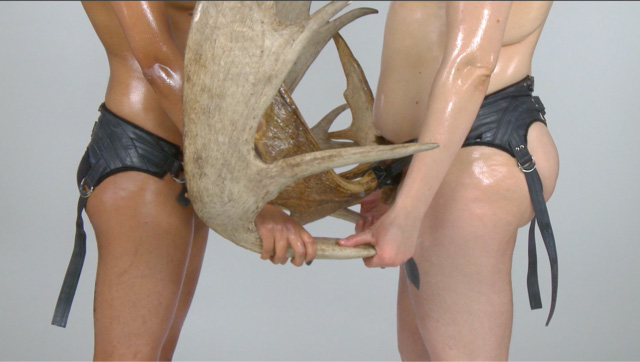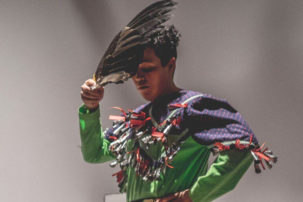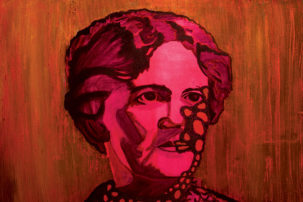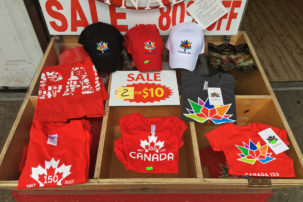At the risk of sounding clichéd, I’ll always remember the first time I saw Kent Monkman’s Miss Chief Eagle Testickle. Having for so long moved through museums that presented only anthropological representations of the imaginary Indian, seeing Miss Chief for the first time was nothing short of revelatory.
I was a little late to the game, and didn’t catch up with her until she was in Tania Willard and Kathleen Ritter’s now-famous survey exhibition “Beat Nation.” Nonetheless, seeing her in all her glory—disco dancing, in a fabulous all-red number, and wearing a necklace comprised of multiple strands of shells exaggerated to a level of supreme luxe indulgence—transformed and inspired me. It was the first time I had seen myself, my most authentic and queerest self, represented in Indigenous art. Yet, I still yearn for a more expansive representation of fierce feminist, gender-variant and sexually diverse realities within Indigenous art. I want a space in Indigenous art for all my bull dykes, bratty baby girls, gender weirdos and dirt fags.
For the purpose of this paper, I will refer to a wide range of sexual and relational practices as gender-variant and sexually diverse. However, the language of the colonizer doesn’t provide a conceptual framework to describe Indigenous gender variance, love and sex. How can we describe Indigenous sex acts as “straight” or “gay,” considering that these terms arise out of colonial constructions of gender, and are defined and read through cis-normative and heteronormative relations—embodied reifications of the neoliberal settler nation state? There is simultaneously an increasing movement among Indigenous youth away from the term two-spirit, which they view as homogenizing of a wide range of identities and practices, and a gravitation towards reclaiming culturally specific and self-determined ways of describing their relationships to gender and sexuality.
Indigenous cisgender women artists of the 1980s and early ’90s have provided lineages of love and embodied womanism that Indigenous artists of today are undoubtedly indebted to in their own ventures into the material. Shelley Niro, Rebecca Belmore, Napachie Pootoogook and Jaune Quick-to-See Smith: these and so many other of the Indigenous women artists of the 1980s and ’90s inspired the next generation with bold works that drew from their bodies, using flesh, bone and blood to give voice to a gendering of colonial violence and dispossession.
But Indigenous feminist art of the late 1990s through the 2010s isn’t the Indigenous womanism of generations past. Indigenous womanism seeks to emancipate entire Indigenous communities, including men, believing deeply that the struggle of our men is our struggle as a people. Next-generation Indigenous feminist artists and thinkers do not seek to reconcile themselves to patriarchal peoples and institutions. Instead they unapologetically take up and take back space. They rage against the gallery and the current affairs of arts administration, asserting that their practices happen in the streets and around kitchen tables; that Indigenous feminist art and cultural writing is self-published, self-distributed and defined within and around community; and, above all, that they aren’t afraid to talk back to the man (or their men, for that matter).
Though Indigenous feminism is only just entering Indigenous art discourse, it’s been here for years. As Erica Lee has written, it’s in the networks of care among Indigenous women who support one another fiercely and uncompromisingly—all the academic and art aunties who share stories intergenerationally of the professors and artists who young women should avoid. It’s the brave survivor who brought sexual assault charges against former OCAD University professor Keesic Douglas, pressuring the university to quickly respond by removing him from their faculty, after a rumoured lack of response and failure to offer recourse to the survivor previous to the charges being filed. Indigenous feminism is Chelsea Vowel and Zoe Todd not letting Joseph Boyden get away with signing off on the UBCaccountable campaign supporting alleged abuser and former UBC professor Steven Galloway—thereby sparking an avalanche of critiques from Indigenous peoples about Boyden’s problematic relationships to Indigenous communities.
In a Canadian Art article last year, Richard Hill asked, “Was Indigenous art better in the 1980s and early ’90s?” Hill described an increasingly insular culture within Indigenous art since that time period, as well as a standstill in authentic art criticism resulting from “conservative identity politics.” Hill’s critical theory asserts that members of the Indigenous art community have come to prefer stymying what little power we possess to voice alternative pathways. In doing so, we uphold the status quo—reify the same colonial logics we are attempting to resist with our cultural productions. Were the 1980s and early 1990s an unparalleled period wherein the Indigenous artist was more political, and less restrained by art bureaucracy?
An Indigenous feminist response to Richard Hill’s provocative line of questioning into the value of today’s Indigenous art—and the mood of today’s Indigenous art community—would likely contend, Better for whom? How authentic is a relationality that requires some of us to maintain devout silence around our lived realities? For me, the 1980s and early ’90s signal a proverbial dead period for Indigenous art portraying sexually diverse and gender-variant realities.
I’m not the first person to make critiques about canonized Indigenous art, which extend far beyond a gendered analysis. I take partial inspiration in writing this from my shero Heather Igloliorte, who publicly asked Hill a different question during his recent lecture at the Leonard and Bina Ellen Art Gallery: Where were all the Inuit within his catalogued account of Indigenous art history, and for that matter, his column for Canadian Art?
There was a resurgence of Indigenous art about sex, sexuality, gender and bodies from the late 1990s onwards. Hill recently told me about “Exposed: Aesthetics of Aboriginal Erotic Art,” an exhibition curated by Lee-Ann Martin and Morgan Wood for the MacKenzie Art Gallery in 1999. Thirza Cuthand has been creating witty and thoughtful video art about the two-spirit movement since the mid-1990s. In fact, one of Cuthand’s first shows was “Native Love” (1995–97)—a series of exhibitions curated by Nation to Nation (Ryan Rice, Skawennati and Eric Robertson). Nation to Nation’s D.I.Y., anti-institutional, and community-based activations allowed them to bring together artworks about sex, AIDS, gender, and queerness before curators, gallerists and arts theorists were even considering the queer possibility of Indigenous art.
Among their many contributions to Indigenous art, Ahasiw Muskegon-Iskwew wrote about Nation to Nation’s “Native Love” exhibition for FUSE in 1996, arguing that it was an important turning point for Indigenous art:
The “Native Love” exhibition is an important attempt in what I hope will be a continuing and increasing concentration on the love, First Nations–style, that is our true strength. This exhibition does not represent the emergence of this topic in First Nations culture. It endeavors to provide an entryway into Western cultural and art historical consciousness for First Nations artists who bear witness to the contemporary power of First Nations love in the living, in ancient voices of the land, non-human loves and lovers, in the ones who have left the physical world but who still speak the strength of family, community and friendship, and especially for those who are coming into being now and in the future. It is a celebration of our own love medicines.
Ten years later, Muskegon-Iskwew would pass on to another realm following an AIDS-related illness. Rene Highway, a promising playwright and choreographer during the 1990s, is another Indigenous artist who left us too soon because of AIDS. June Scudeler has done extensive work historicizing Highway’s powerful, but obscure, work that dealt with complex issues of gender, sexuality and colonialism. All of this raises another question: How many of our gender-variant and sexually diverse peoples have we lost because of the high rates of HIV that devastated our communities in the 1980s and early 1990s? And, as I’ve argued elsewhere, the rates of HIV within the Indigenous community remain high, as does the occurrence of AIDS-related illness and death—which is largely invisibilized.
Yet these pivotal efforts are not present in the Indigenous art canon, in the dominant historicization that we pull from gallery catalogues and museum collections. What makes these experiences inherently less Indigenous, and less worthy of representation in the gallery space? The more I talk with mentors, scholars and artists in my field, the more I realize that there are two Indigenous art histories: the galleried art history, and the community telling of Indigenous art history. When you sit down to talk with Indigenous artists and art historians from previous incarnations of the Indigenous art community, you are flooded with names, situations, events and rememberings—figures that didn’t make the history texts and museum collections, but are nonetheless central figures in fostering Indigenous art of their time.
The space of the gallery, and the very scaffolding of arts administration itself, has facilitated an erasure of gender-variant and sexually diverse realities from Indigenous art. The fixation on art catalogues as historical record, and the attempt to define one singular Indigenous art canon to fit neatly within the white box, are both integral to this system of erasure. We have to recognize that the vast majority of the gallerists and arts administrators of the 1980s and ’90s were white. These administrators, through their curation, and reinforced by the top-down hierarchy of arts funding in Canada, were able to pick and choose who was shown in galleries at the time, and which catalogues were funded.
Because a great majority of the artists who comprise the catalogues and collections of the 1980s and ’90s emerged from this troubled history, the art of this period largely focuses on themes of political resurgence, sovereignty, museological criticism and Indigenous identity—as if complex genders and sexualities aren’t a part of our identities to begin with. Gender-variant and sexually diverse Indigenous artists weren’t, or perhaps weren’t permitted, to create art that drew from their bodies, genders and sexualities for content that was being shown in major galleries, and therefore canonized. These kinds of art were relegated to community-based practice, and seen as somehow not formal, professionalized or serious. This is not an accusation. Structural differentiation can become encoded within our relations as Indigenous kin because of a pervasive shame in our communities around sexuality, resulting from legacies of colonialism and residential schooling.
Nonetheless, it wasn’t until the 2000s that we see genderfucking openly and unapologetically represented in Indigenous art. Adrian Stimson’s Buffalo Boy would gallop onto our radar, at times alongside Lori Blondeau’s gun-toting bull dyke Belle, in the early 2000s. One of Dayna Danger’s favourite photos, Momma Has a Pony Girl…(Named History and Sets Her Free) by Dana Claxton, wouldn’t be created until 2008. Perhaps the true burden of Indigenous art is not its identity politics, but its lack of identity—or rather, its singular subjectivity. Indigenous art has lost entire portions of our community whose practices resisted institutionalization and didn’t easily fit into the masculinist, cisnormative and heteronormative subjectivity of Indigenous art.
Indigenous artists like Dayna Danger, Moe Clark, Ange Loft, Kiley May, Raven Davis, Beric Manywounds, Fallon Simard, Melody McKiver and Erin Konsmo—to name only a few— are part of a current resurgence of Indigenous artists who are unapologetically creating from their bodies, genders and sexualities. This work of finding our sexually diverse, gender-variant and openly sensual relations within Indigenous art can be done by reclaiming visual histories that were left out of the dominant canon—like Michelle McGeough’s work reclaiming the erotic paintings of Norval Morrisseau—but it also must entail the active support of diverse voices within Indigenous art. We are your kin too.
I felt humbled to recently chair a panel at the Feminist Art Project’s day of panels on the theme of Indigenous feminism at the 2017 College Art Association conference, organized by Maria Hupfield and Kat Griefen. I was reminded that this work of reclaiming the sensual has a long history before me. I’m still reeling from when Muriel Miguel (Spiderwoman Theatre) addressed my panel with Dayna Danger, Tarah Hogue, Marcella Ernest and Lyncia Begay. She told us about a 1970s performance she did in San Francisco wherein she “had sex with a chair.”
Miguel described the sensuality of the chair: running her fingers along its curves, in between its rods, and straddling it. Minguel then asked us, in reference to our work around sex and sensuality, “What do you want?” Dayna Danger responded by comparing her work to a dam with a crack in it, centuries of water pounding against it, ready to burst—a water/orgasm metaphor. Miguel and Danger reminded me that expressing our sensualities, sexualities and genders without stigma is the work of warriors. And perhaps this is our power: though we have been forgotten, suppressed and lost, we still persist—with love.
As my mentor Heather Igloliorte has pointed out to me in reading earlier drafts of this essay, my argument isn’t actually that Indigenous art is better from the late 1990s through the 2010s, but that it will continue to become better. Indigenous art is just now learning how to create a space for gender-variant and sexually diverse voices that were absent from the dominant discourse for the past several decades. In the same vein, Hill’s essay didn’t conclude that Indigenous art was indeed better in the 1980s and early ’90s, but that there are new institutional forces, some of them Indigenous-governed, that have supported redundant gestures.
Indeed, there are still institutional forces within Indigenous art that require the interventions of fierce Indigenous feminism. Indigenous art is now poised to surpass its former corrosive identity politics that rely on rigidity and uniformity, like a dam of water ready to burst.
Lindsay Nixon is Indigenous editor-at-large at Canadian Art.
This article has been changed. An unsubstantiated reference to Professor Taiaiake Alfred of the University of Victoria has been removed. We regret any harm this has caused.

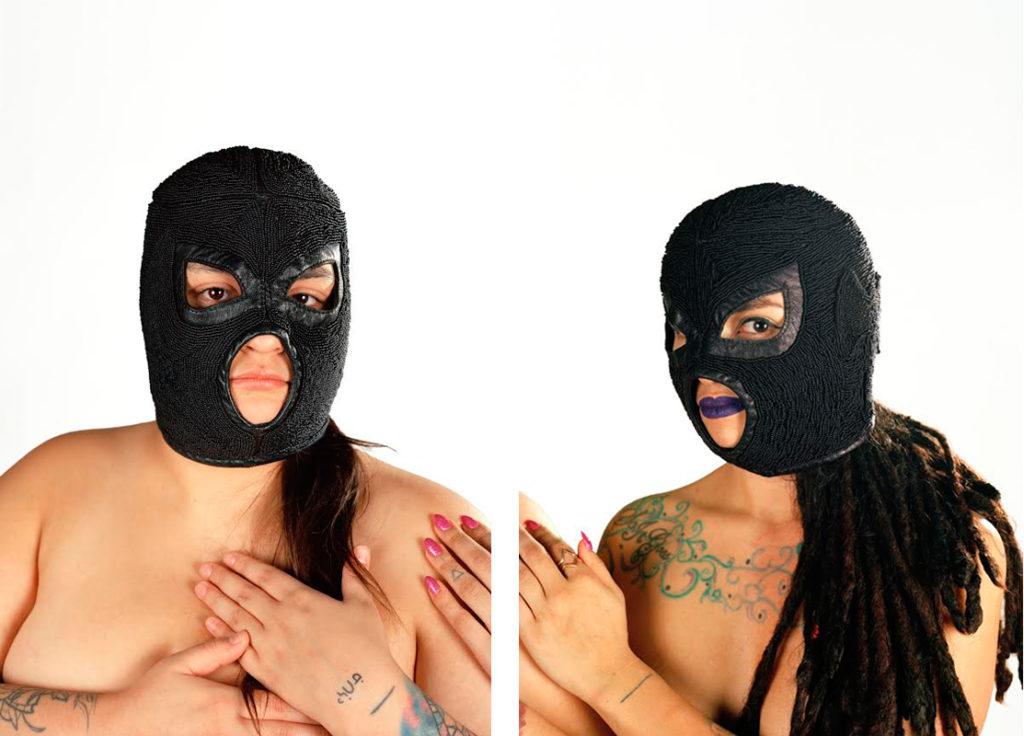 Dayna Danger’s photographs Lindsay (left) and Sasha (right). Courtesy the artist.
Dayna Danger’s photographs Lindsay (left) and Sasha (right). Courtesy the artist.
